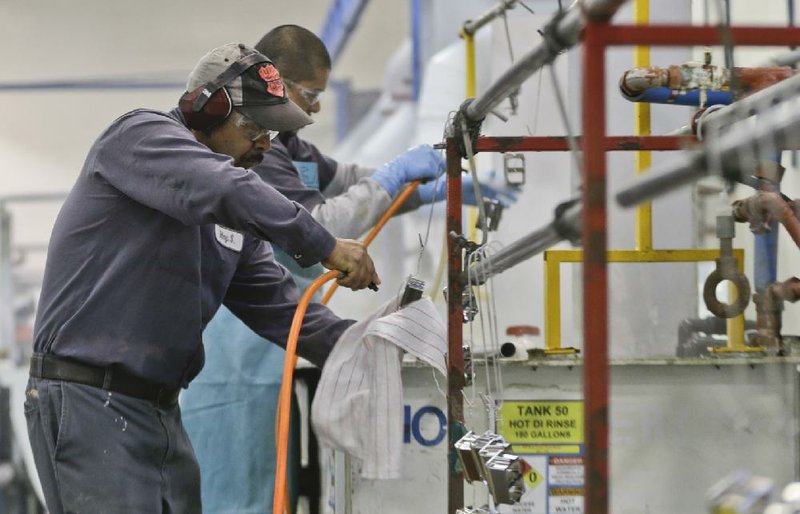WASHINGTON - U.S. productivity grew at an even slower annual rate than previously thought in the final three months of 2013.
Economists are hoping productivity growth will revive in 2014, reflecting a stronger economy.
Productivity grew at an annual rate of 1.8 percent in the October-December quarter, a slowdown from 3.5 percent productivity growth in the third quarter, the Labor Department reported Thursday.
The new estimate was lower than the 3.2 percent gain the government had previously reported. Unit labor costs dipped 0.1 percent, a smaller drop than the 1.6 percent decline previously estimated.
For the year, productivity increased 0.5 percent, continuing a weak trend seen over the past three years. Analysts are forecasting a rebound in productivity this year, helped by stronger economic growth.
Productivity is the amount of production per hour of output. The downward revision for the fourth quarter reflected that output, as measured by the gross domestic product, was lowered from the government’s initial estimate.
The fourth-quarter growth rate for gross national product, the nation’s total output of goods and services, was revised to 2.4 percent, down from the previous estimate of a 3.2 percent growth rate. With less output, productivity was revised lower.
The 0.5 percent rise in productivity for all of 2013 was down from a 1.5 percent increase in 2012. It compares with an identical 0.5 percent rise in 2011. Labor costs edged up a slight 1.1 percent in 2013, continuing a trend of modest gains in labor costs.
Economists expect that with a stronger economy this year, productivity will show gains as well. Analysts at JPMorgan are forecasting that productivity will increase by 2.1 percent in 2014.
Greater productivity raises living standards because it enables companies to pay their workers more without having to raise prices that could increase inflation.
The Federal Reserve monitors productivity and labor costs for any signs that inflation could pick up. Mild inflation has allowed the Fed to keep short-term interest rates at record lows and purchase bonds to try to keep long-term rates down.
The Fed in December and again in January announced that it was reducing its monthly bond purchases, taking them from $85 billion per month down to $65 billion.
But at the same time, the Fed strengthened its commitment to keep short-term rates low for an extended period. It expects to keep those rates low “well past” the time that unemployment dips below 6.5 percent. The unemployment rate in January dropped to 6.6 percent.
The Federal Open Market Committee’s next meeting ends March 19. Its view on the economy could be complicated by distortions created by harsh winter weather.
“What we need to do, and will be doing in the weeks ahead, is to try to get a firmer handle on exactly how much of that set of soft data can be explained by weather and what portion, if any, is due to a softer outlook,” Fed Chairman Janet Yellen said while speaking to the Senate Banking Committee on Feb. 27.
The Fed has the room to keep interest rates at record lows to help the economy because inflation is running well below the central bank’s 2 percent target.
In records going back to 1947, productivity has been growing by about 2 percent per year.
Orders to U.S. factories fell in January for a second-straight month, but a key category that signals business investment plans rebounded. That could be an indication that businesses are becoming more confident.
Factory orders dipped 0.7 percent in January, the Commerce Department reported Thursday.
That followed an even bigger 2 percent decline December, which was a larger decrease than first reported and the biggest decline since July. The weakness in both months was led by large declines in demand for commercial aircraft.
Orders for core capital goods, a proxy for business investment, rose 1.5 percent in January, recovering after a 1.6 percent drop in December.
Demand for durable goods, items expected to last at least three years, were down 1 percent in January while nondurable goods orders slipped 0.4 percent.
The estimate for durable goods was unchanged from a preliminary report. The weakness reflected a 20.2 percent drop in orders for commercial aircraft, a dip that followed an even bigger 22.3 percent fall in December. Orders for motor vehicles and parts fell 0.9 percent, the second-straight decline.
Orders for primary metals such as iron, steel and aluminum dropped 1.2 percent while demand for machinery was down 0.7 percent and computer orders fell 46 percent.
Information for this article was contributed by Martin Crutsinger of The Associated Press and by Jeanna Smialek and Chris Middleton of Bloomberg News.
Business, Pages 27 on 03/07/2014
